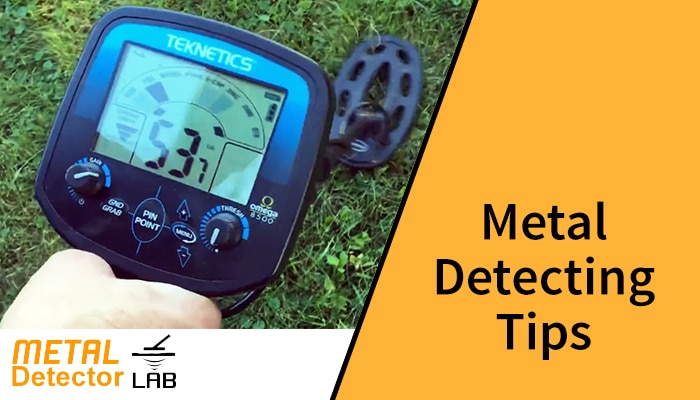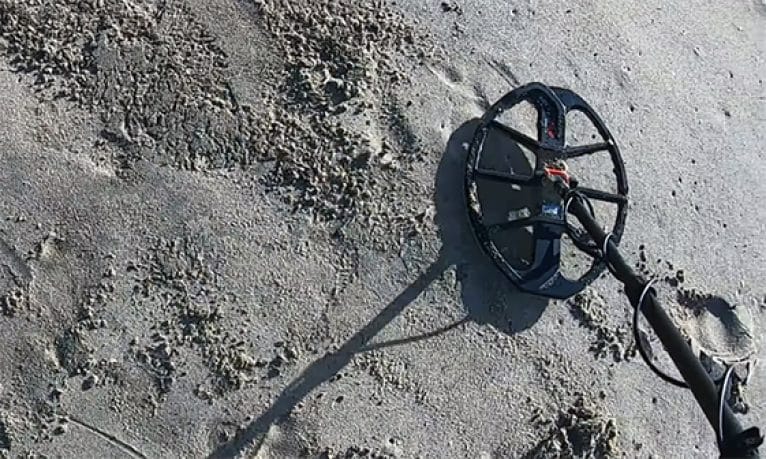Metal Detecting Tips & Tricks

Learn The Right Way To Metal Detect
You should first understand how to metal detect properly. When you're not doing it correctly, you're not going to be very successful. Since every gadget is a little different, sure to read the user manual and learn how to use it properly.
Technique is also significant, and any system uses the same technique. ‘Low and sluggish' is the general law. Shift the metal detector slowly and as low to the ground as possible. It will guarantee that your metal detector can detect targets with the greatest precision.
Go out there and practice metal detecting once you've learned how to do it properly. Practice makes great in this hobby. You might hide some coins in your backyard as a beginner to see if you can find them using the metal detector.
Start In Your Own Backyard

After you first get a metal detector, you'll want to do a lot of testing to figure out what settings work best for you. Why not dial it in at home instead of trying to sort it out after you've gone to a special location? Who knows what could be hiding in plain sight in your own yard?
Personally, I was able to find a variety of old tools, coins, and, of course, nails, pop-tabs, and foil after thoroughly checking my entire home. But I was able to figure out how to use features like discrimination, ground-balancing, sensitivity, and even tone volume adjustment.
Find Historically Significant Areas
Metal detecting is great in areas like parks, schools, and old ball fields, but often people ignore the less visible sites. Old coins can be found with a metal detector in almost every grassy area that has seen foot traffic in the past. Look to see if the city hall or historical society has an old map that shows when various parts of the city were annexed.
I like maps from the 1930s because they should have a lot of streets on them because they've all existed for a long long time. If you have an old map, you'll only be able to locate a few streets. Then, using Google Earth's aerial view, search these areas for grassy areas to metal detect.
Research
Look for books about your area's early history at your nearest historical society and library. Old photographs, maps, and stories from old-timers will lead you to good hunting spots. Maps and deeds dating back to the county's early history are also good resources for seeing old road and riverbeds, and aerial photos can show you areas where roads and water sources used to be.
Old topographical surveys are a valuable resource if you've narrowed down the address of an old site to a general area. An old topographical map was used by one relic hunter to locate an 18th century Indian trade routes on the Ohio River.
Use A Metal Detector For Beginners
While you are still new to this kind of digging, you will benefit greatly from a good all-purpose metal detector made for beginners. With a frequency range of 5-8 kHz, these devices are accessible to anyone, regardless of financial status, and are capable of finding assorted treasures such as coins, jewelry, and relics.
But, regardless of what kind of target you're looking at, keep in mind what kind of ground you're on. To make your detector more water-resistant, you'll want to get a waterproof or submersible one.
Test With Different Metals
Try using your detector with different metals before going to a real search site. Try burying it underground with common items like a coin and a nail. Examine the metal detector to see if you can detect them. This step is particularly useful when dealing with VLFs that have phase changes.
Don't Give Up On Questionable Targets
Digging through the signs that don't seem to be motivating or that don't seem to mean something of importance can be worthwhile. If you have the patience, dig those ambiguous targets because they could be something special.
Beach Metal Detecting

Beach metal detecting is a very different experience. At the beach, you can find everything from traditional coins to extremely expensive gold and silver items. Thanks to Spanish shipwrecks over the years, some beaches also yield valuable old coins periodically. In reality, there are plenty of garbage targets in the sands of the beach too, but it's well worth your time.
The most expensive things people are likely to discover on most beaches are jewelry. People set down their beach towel and leave their valuables on the beach, where they will become sand-covered. They even go swimming, where the cold water shrinks their fingers, allowing rings to fall off easily.
There is a chance of finding highly valuable jewels in especially wealthy places. Metal detectorists have been known to come across rings or large necklaces made of platinum or gold that are valued at several thousand dollars. Metal detecting at the beach will definitely be profitable if you have enough patience.
High Tide Line
Aim for the softest high-tide line and walk along it, as this is also the most productive. Sort through the trash and look for something out of the ordinary. A screened gadget at the end of a handle will eliminate a lot of bending over, but basic garden tools like a hand scoop or pail will do the trick.
Storms
After a storm has passed over the ocean, go to the beach as soon as it is possible to do so. Strong ocean currents stir up sediment and sometime pick up items, such as coins, and tosses them onto the beaches.
Shell Deposits
Look for places with the most shell deposits, as this could mean where strong waves are washing through the beach sand and depositing loose objects.
Search the Towel Line
Beach metal detectorists are well-known for their towel rows.
The towel line is a popular spot for beachgoers to hang their towels. It's above the high tide level, normally marked by a row of seaweed or other debris left behind by the sea.
Sun-seekers unload their bags here, apply sunscreen that makes their fingers slick, and rummage through their luggage. Objects are falling off and out at an unprecedented rate.
Depending on the quality of your detector, you'll find sunglasses, phones, coins, and jewelry along the towel line, as well as Coke cans, beer cans, and tin foil.
Use Low Discrimination Settings
The discrimination degree refers to the detector's sensitivity as well as the types of metal it can detect. Keeping your discrimination level low could cause your machine to warn you to any piece of foil and aluminum can you come across; however, it can also pinpoint very great finds like Celtic or Roman coins, which are small and thin (and therefore will go overlooked at a high discrimination level) and contain a lot of nickel. Furthermore, if you go for extended periods of time without finding something, children will lose interest.
Local Parks

Many experienced metal detectorists recommend going to a playground or public park pfor your first metal detecting trip. The reason is that digging there is really easy and you will probably find a coin or two. The areas with mulch or sand is what you're searching for. Keep your quest head flat and offer a strong, steady swing. Raising the coil at the end of the swing is the most common error made by beginners. You won't have the same range as in the center of your swing if you do this. Also, and this is crucial, search in “All Metal Mode” when you just start detecting. You'll get a sense of how different signals sound. Test the pinpointer feature and the depth indicator if the detector has them.
It's probably safer to leave the shovel in the car if you're hunting in a busy park. Heavy digging tools can attract a lot of attention, particularly if you're in a well-kept park. Rather, a small handheld trowel would do the job perfectly. It's important to understand how to dig plugs properly in these situations. Other park visitors can look down on you if you leave holes and stacks of dirt behind, which could put an end to your treasure hunt. Do your homework and acquire knowledge about proper retrieval techniques.
Don't Leave a Mess
Wherever you dig, you should always take care not to leave a mess. It's a major no-no to leave holes unfilled or dirt scattered all over the lawn. When I dig a pit, I still put the block of dirt on top of a cloth to keep dirt crumbs off the grass.
In the summer, never dig a hole in extremely hot weather. When you do, the grass can quickly perish. When there is a chance of rain, it is safer to dig holes in the cooler weather. It should always be the intention to make it seem as if no hole was ever dug.
Search Busy Areas
Selecting a search location is just as critical as selecting the appropriate detector. Choose a location that has the best chance of producing what you seek. The more people who have visited the location where you will be searching, the higher the probably you are to come across some incredible finds.
Of course, you must also ensure that you are permitted to hunt in a particular location. Before you begin, check city ordinances and obtain permission from landowners. At a beach, property is owned all the way to the high tide mark. Below that, it is generally acceptable to search. Certain upscale hotels are extremely protective of their guests. Respect is critical.
Timing is also critical. For instance, you're more likely to find a secluded beach when it's not tourist season than you will be on a popular tourist spot during the peak seasons. A h-traffic area does not need to be newly constructed. Previously frequented research areas. Old beach boardwalk locations, shores close to the old Spanish wreckage and more may yield. Metal detectors have even been used to help find garbage trenches on abandoned farms that produced collectible glass bottles in the past. Determine what you're looking for and conduct the necessary research.
Your Search Patterns Should Overlap
When you arrive at a new hunting spot, it's tempting to be in a hurry to explore. One of the most popular beginner mistakes is not adequately overlapping your metal detector sweeps, which can result in you missing a lot of targets.
A good way to find your target is to walk a straight line until you approach the perimeter of the area. To avoid missing something, ensure your sweeps overlap as you walk. Return the way you came, turning around and taking a slight step to the left. Stepping 1-2 feet away from your previous path allows for a small overlap without taking much extra time.
However, failure to overlap is also not the only way to miss goals. Smaller goals can go unnoticed if you're driving too far. To get the best results, make sure your swings are well-controlled.
You should also hold the coils parallel to the soil at all times. When you lift your coil at the conclusion of a swing, you are not searching at the same depth all the way through the swing.
Re-Scan Every Hole You Dig
You will probably be surprised at the number of targets that share the same area. I frequently come across clusters of coins on the beach. Additionally, tidal action can create pockets of items, sometimes stacked one on top of each other. Some detectorists may even search previously dug holes, frequently discovering targets that were overlooked.





